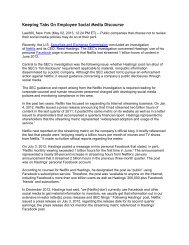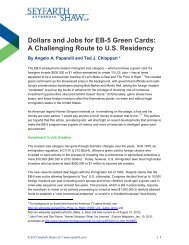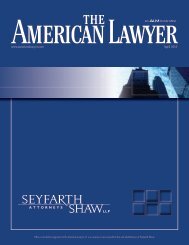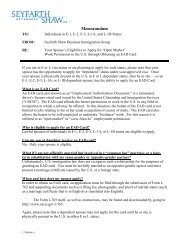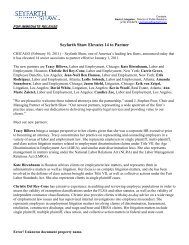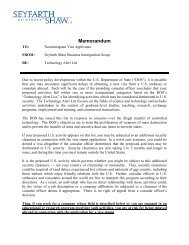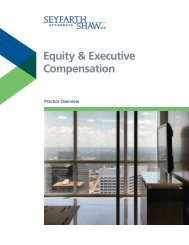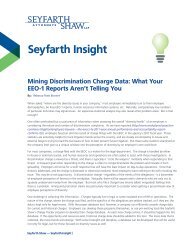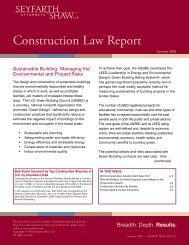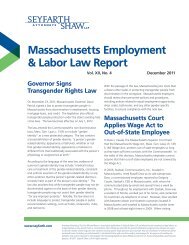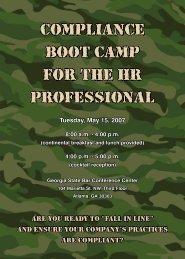Litigating California Wage & Hour and Labor Code Class Actions
Litigating California Wage & Hour and Labor Code Class Actions
Litigating California Wage & Hour and Labor Code Class Actions
Create successful ePaper yourself
Turn your PDF publications into a flip-book with our unique Google optimized e-Paper software.
Bell court to look beyond the <strong>Wage</strong> Order’s language. In contrast, <strong>Wage</strong> Order 4-<br />
2001 (the current <strong>and</strong> operative <strong>Wage</strong> Order in Harris) incorporates specific federal<br />
regulations <strong>and</strong> contains “detailed guidance” concerning the administrative<br />
exemption. The Court of Appeal in Harris erred by focusing too heavily on the<br />
administrative/production dichotomy rather than applying the language of the relevant<br />
wage order <strong>and</strong> regulations.<br />
The Supreme Court ultimately declined to adopt a rule precluding the use of the<br />
dichotomy as an analytical tool. Instead, the Court held that, in determining whether<br />
work is administrative, courts must consider the particular facts <strong>and</strong> apply the<br />
language of the statutes <strong>and</strong> wage orders at issue. If the statutes <strong>and</strong> wage orders<br />
fail to provide adequate guidance, the Court held, then it would be appropriate to<br />
consider other sources, including, presumably, the administrative/production<br />
dichotomy.<br />
The only concrete guidance from the <strong>California</strong> Supreme Court in Harris is that the<br />
administrative/production dichotomy is not a dispositive test for the administrative<br />
exemption. The Court left open the possibility that the dichotomy may still apply in<br />
future cases. Employers who were looking for more specific guidance from the Court<br />
on the administrative exemption will be disappointed, as, even after Harris,<br />
determining whether an employee satisfies the administrative exemption remains a<br />
highly fact-specific venture.<br />
D. The Outside Sales Exemption<br />
The outside sales exemption is the broadest of all in that it exempts the employees from all<br />
provisions in the <strong>Wage</strong> Orders, even minimum wage protections. 49 To qualify as an outside<br />
salesperson, an employee must “customarily <strong>and</strong> regularly work more than half the working<br />
time away from the employer’s place of business selling tangible or intangible items or<br />
obtaining orders or contracts for products, services or use of facilities.” 50 This definition is<br />
slightly different from the definition of an outside salesperson under the FLSA, which<br />
provides that to be an outside salesperson, an employee must (1) customarily <strong>and</strong> regularly<br />
be engaged away from the employer’s place of business making sales or obtaining orders<br />
or contracts; <strong>and</strong> (2) must spend no more than 20 percent of the work time on other nonexempt<br />
tasks unless the tasks are incidental or in conjunction with the employee’s outside<br />
sales or solicitations.<br />
49<br />
50<br />
IWC <strong>Wage</strong> Order 1-2001(1)(c) (“the provisions of this wage order shall not apply to outside salespersons”). By<br />
contrast, the white collar exemptions exempt employees only from Section 3 through 12 of the <strong>Wage</strong> Orders <strong>and</strong> other<br />
exemptions exempt employees only from Section 3 (governing hours of work).<br />
IWC <strong>Wage</strong> Order 1-2001(2)(j) (defining “outside salesperson”).<br />
Seyfarth Shaw LLP | www.seyfarth.com <strong>Litigating</strong> <strong>California</strong> <strong>Wage</strong> & <strong>Hour</strong> <strong>Class</strong> <strong>Actions</strong> (12th Edition) 15



